Typically, when you buy a board game, it comes in a box. If it didn’t, it would be fairly difficult to get it home, you’d probably lose things, etc, etc.
That said, there are boxes and there are boxes. Some games arrive in a box that is the perfect storage solution, whilst others are clearly not fit for purpose. Increasingly, I find myself building custom inserts for boxes, and thought I might offer a few thoughts in game boxes generally.
Vast, Cavernous and Empty
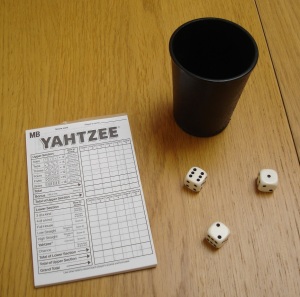
This was always the way games seemed to be done historically – If you think of a game like Yahtzee, it would typically come in a box the size of a couple of massive hardback novels, yet what you got inside was a pad of paper, 5 dice, some pencils, and a cup.
Given that the cup is superfluous, and most people already have pens or pencils at home, this could probably have been compressed substantially.
On the flip side, if you do despair of the massive box and chuck it, you may end up losing some of the components
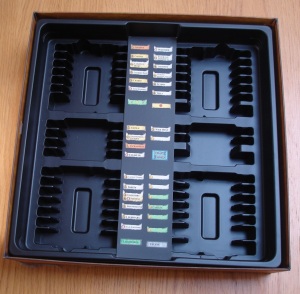
Moving to move modern games, this is still a phenomenon we see regularly.
A Dominion set, or a new installment in the Legendary series will generally come in a large box, often with a plastic insert that looked like it could have been designed explicitly to fill out a box, and make it look like you were getting more than just a couple of decks of cards.
Expanding
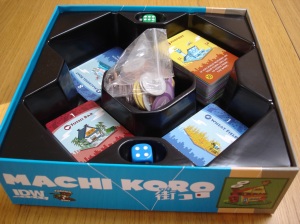 Of course, one reason to have a big box is if the game is destined for lots of expansions. The instant I opened up Machi Koro for the first time, I could tell that they had expansions planned – the box insert is still blotting out about half of the available space in the box, but once you’ve added an expansion or two, at least the insert itself doesn’t look too empty.
Of course, one reason to have a big box is if the game is destined for lots of expansions. The instant I opened up Machi Koro for the first time, I could tell that they had expansions planned – the box insert is still blotting out about half of the available space in the box, but once you’ve added an expansion or two, at least the insert itself doesn’t look too empty.
When you do get expansion after expansion though, you need to decide at what point you start splitting or combining the sets. I’ve long-since ditched the box for Machi Koro’s Harbour expansion, which would potentially be an issue if I ever wanted to split them up (for example to sell the expansion and keep the base game).
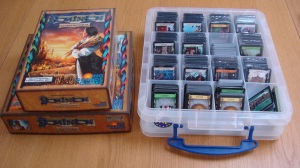
Beyond a certain point, it just gets silly. It’s actually been quite a few years since I ditched the boxes for my Dominion collection, but if I still had them, I’d be looking at 5 large boxes and 2 small ones by this stage – that’s pretty much an entire shelf on the gaming case.
Instead, I bought a really useful box – this holds all the cards, and 95% of what I need for any game (there are one of two other odds and ends, plus some unused duplicates that I keep in a lone small box.
No Room at the Inn
The other issue with expansions goes the other way: I have a very early copy of the Firefly Boardgame, one which came in a compact box that was absolutely rammed full of stuff- obviously, there is an insert here, but I don’t think I’d be saving much space if I took it out.
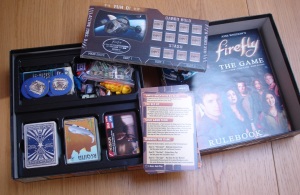 The problem is, when I’ve looked at the possibility of getting expansions in the past, most of the smaller ones which caught my eye didn’t come in the sort of size/shape/solidity of box that I’d want to use for long-term storage. If I’d bought the later edition, with the longer box, I could probably have squashed them in, but instead I’ve left my Firefly collection without expansions beyond the original “Breaking Atmo” deck.
The problem is, when I’ve looked at the possibility of getting expansions in the past, most of the smaller ones which caught my eye didn’t come in the sort of size/shape/solidity of box that I’d want to use for long-term storage. If I’d bought the later edition, with the longer box, I could probably have squashed them in, but instead I’ve left my Firefly collection without expansions beyond the original “Breaking Atmo” deck.
Looking for components in all the wrong spaces
Sometimes there are games which come in a box that’s plenty big enough for all the stuff you’ll need to fit in it, but the inset prevents you. This can be bad design on the part of the manufacturers, or it can simply be the result of a different design philosophy.
The Original
 Pathfinder Adventure Card Game is the perfect example of this. Each version of the game comes with a very similar looking plastic insert, designed to hold the cards by type, with separate spaces for constructed character decks, and other slots for the various expansion adventures.
Pathfinder Adventure Card Game is the perfect example of this. Each version of the game comes with a very similar looking plastic insert, designed to hold the cards by type, with separate spaces for constructed character decks, and other slots for the various expansion adventures.
The space for the expansion boxes was always a bit annoying: once you actually crack open the later adventures and start playing them, the cards all go in with the others of that type. Putting the cards back in their boxes is something that would only be relevant if you were going back to the beginning of the AP and play through it again, and even then, it isn’t the only option available.
I’ve had 3 Pathfinder APs now, and have taken a slightly different approach to each of them.
Rise of the Runelords
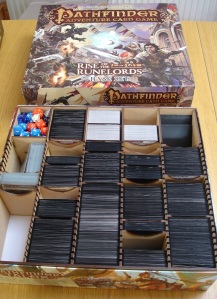 Rise of the Runelords was the first AP, and it had a few issues – for one thing, the factory who printed the cards seemed incapable of getting the colours right, and the company behind the game decided to switch to a new printer- this made for a lot more stability long-term, but in the short-term, it meant a shift mid-cycle to noticeably different card backs. The card-back issue meant that in certain scenarios, you could identify the henchman/villain simply from the card-back, which is the type of information that you are definitely not supposed to have access to.
Rise of the Runelords was the first AP, and it had a few issues – for one thing, the factory who printed the cards seemed incapable of getting the colours right, and the company behind the game decided to switch to a new printer- this made for a lot more stability long-term, but in the short-term, it meant a shift mid-cycle to noticeably different card backs. The card-back issue meant that in certain scenarios, you could identify the henchman/villain simply from the card-back, which is the type of information that you are definitely not supposed to have access to.
In the end, I splashed out for this one, and bought a wooden custom box insert. Broken Token seem to be the market leaders in this area, but availability outside of North America is not great, so I got mine from another company (I forget now whether it was Amazon or Ebay). The wooden insert is really solid, and offers a nice amount of flexibility. The only issue is that the rows aren’t wide enough for the baggy-fit penny sleeves that I normally use, and to fit properly, you have to have the more expensive standard-quality sleeves: For Runelords I’d decided to get those sleeves anyway, to hide the differing print-runs, so it wasn’t too bad.
This is definitely one of the nicest-looking storage solutions for a game that I have. It’s also, undoubtedly the most expensive. I don’t begrudge the spending on the sleeves that much, as the cards would have been shredded by now, given how many times we’ve played this game, but it probably wasn’t the most efficient way forward.
Skull & Shackles
 For AP2, Skull and Shackles, I made my own insert – I had the whole path in penny sleeves, and wanted to keep the costs down. I also had a growing number of the class decks, which arrive in impractically wide and shallow boxes that I wasn’t keen to keep, to I was able to accommodate a few of these as well.
For AP2, Skull and Shackles, I made my own insert – I had the whole path in penny sleeves, and wanted to keep the costs down. I also had a growing number of the class decks, which arrive in impractically wide and shallow boxes that I wasn’t keen to keep, to I was able to accommodate a few of these as well.
Obviously this lacks the elegance of the Runelords insert. However, I doubt it cost me any more than a fiver in materials: the base is heavy card (artists’ mountboard iirc) and the walls are foamboard. A few of the dimensions aren’t 100% ideal – I wish I’d allowed more space to mix in class-deck cards, but overall, this feels very functional and efficient.
Wrath of the Righteous
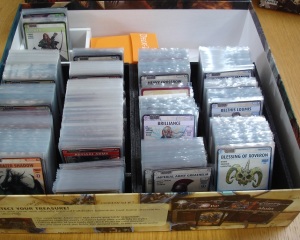 Lastly (so far) was AP3 – Wrath of the Righteous. As I’ve talked about a length elsewhere, we didn’t really get on with this path, and whilst it contains some cool stuff we wouldn’t want to lose, I certainly wasn’t in any mood to go shelling out loads of cash on the box. Fortunately, I had these trays which I’d originally used for Runelords, they are all foamboard, and were done without less of the precise measuring than employed for the later sets – this means that some compartments are a bit too big, and others are quite snug, but it generally works a fairly multi-purpose tray.
Lastly (so far) was AP3 – Wrath of the Righteous. As I’ve talked about a length elsewhere, we didn’t really get on with this path, and whilst it contains some cool stuff we wouldn’t want to lose, I certainly wasn’t in any mood to go shelling out loads of cash on the box. Fortunately, I had these trays which I’d originally used for Runelords, they are all foamboard, and were done without less of the precise measuring than employed for the later sets – this means that some compartments are a bit too big, and others are quite snug, but it generally works a fairly multi-purpose tray.
Other crafting
Aside from the Pathfinder inserts, I’ve made foamboard trays for a few other games – For Lord of the Rings LCG, these have typically been open boxes that are the sole storage for that bit of the game.
 The most recent, and perhaps the most ambitious was for Mansions of Madness. I’d already done some customisation on the figures, painting them up, and putting them onto clear bases (an idea I nicked from a guy on BoardGameGeek, but I now needed somewhere to put them – stacking all the loose components and the miniatures on top of the tiles was tricky, and with expansions in the works, it was clearly all going to go wrong.
The most recent, and perhaps the most ambitious was for Mansions of Madness. I’d already done some customisation on the figures, painting them up, and putting them onto clear bases (an idea I nicked from a guy on BoardGameGeek, but I now needed somewhere to put them – stacking all the loose components and the miniatures on top of the tiles was tricky, and with expansions in the works, it was clearly all going to go wrong.
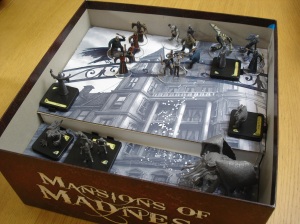 I made a foamboard tray for the tiles, with a shelf to go on top and hold the miniatures. The end section was left for the cards and tokens, but I had an added problem that the Star Spawn figures are so tall that they wouldn’t fit inside the box if I made their shelf as high as it would need to be to hold all the tiles – I therefore ended up with a split-level insert.
I made a foamboard tray for the tiles, with a shelf to go on top and hold the miniatures. The end section was left for the cards and tokens, but I had an added problem that the Star Spawn figures are so tall that they wouldn’t fit inside the box if I made their shelf as high as it would need to be to hold all the tiles – I therefore ended up with a split-level insert.
Typically I make these inserts fairly plain and functional, but I still had the original box insert from FFG – a really nice piece of art, printed onto some strangely-folded cardboard that could have been designed for the sole purpose of making it harder to put things in the box. I cut a few bits to size, and stuck them to some slightly more solid card to cancel out the folds and flaps and (after a few mis-judged attempts, and a fair bit of trimming, it was done).
Overall, I’m pretty pleased with this- it certainly makes it a lot easier to store in the short-term. Long-term, a lot of the aesthetics will be lost, when I have to add in the extra-large tiles, but I decided that I’d rather have them lying on top than sacrifice the support underneath the large shelf – better have it look a bit plain than have it cave-in.
Overall thoughts
I don’t think that there is a perfect solution to the question of box sizes – make it too small and there’s no room in the box for expansions, make it too big and there’s no room on the shelf (or if you don’t bother with expansions). Build it to hold sleeved cards, and unsleeved ones will rattle around and fall out, make it for unsleeved, and sleeved cards won’t fit.
 Overall, I think that between foamcore and Really Useful Boxes, there’s generally a solution to be had, typically at a fairly sensible price. Obviously I’d love to have enough money to put all my games in Broken Token style boxes, but I need to be realistic.
Overall, I think that between foamcore and Really Useful Boxes, there’s generally a solution to be had, typically at a fairly sensible price. Obviously I’d love to have enough money to put all my games in Broken Token style boxes, but I need to be realistic.
I’m just going to leave you all with a picture of the Alhambra Big Box, undoubtedly the best storage solution I’ve found that comes with the game itself. Of course, even that has its problems, as I’ll be talking about soon…

[…] few weeks here on Fistful of Meeples, as I’ve talked a lot about numbers, lists, statistics, and even storage inserts. Whilst this is the sort of thing that often fills my mind, I’m aware that it may not be the most […]
LikeLike
[…] has a very specific slot to go in, with a photograph to guide you when putting stuff back. As a big fan of optimised storage solutions, this seemed like a […]
LikeLike